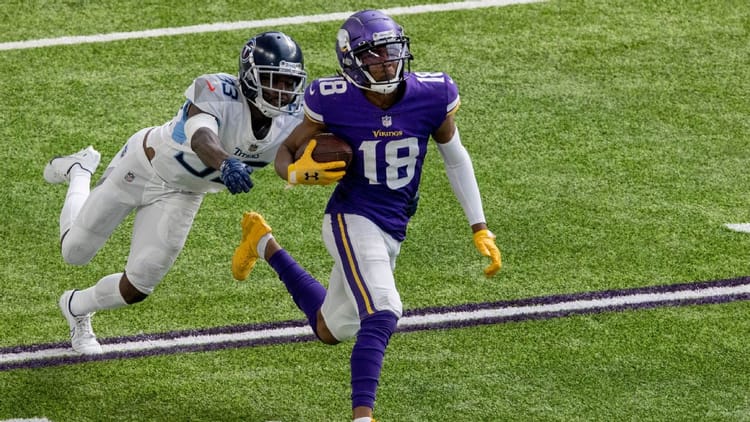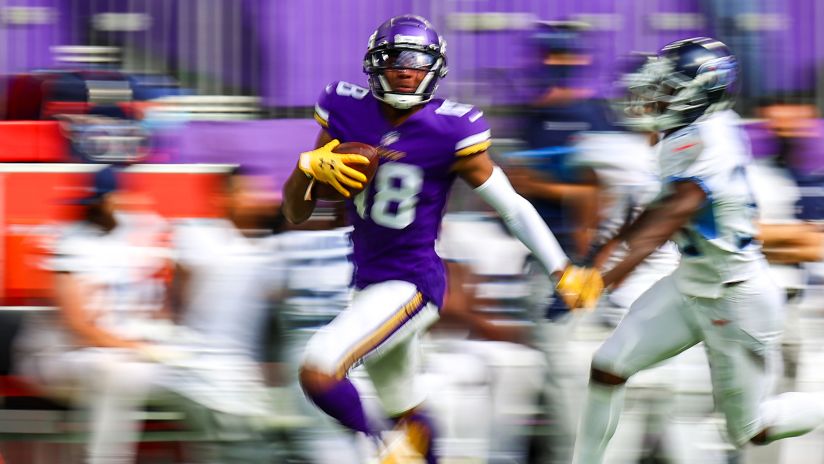The Context of Justin Jefferson’s Breakout

Justin Jefferson is by default now the team’s WR2 and even contributed as a bonafide WR1 last weekend. Seventh-year wide receiver Adam Thielen will remain as the Vikings trusted pass-catching option while Jefferson will sprinkle in the pizazz. In this respect, think Thielen and
Diggs, although Jefferson has more speed than the Buffalo Bills wide receiver.
Indeed, Jefferson’s production is largely an “only one game” situation, but he will soon make the case that the Titans showing was not an outlier. Jefferson has been a playmaker at every level of football and has a National Championship with LSU to bolster his case for legitimacy.
The coaching staff muzzled the 21-year-old for a couple of weeks to kick off the 2020 season,
presumably so he could become acclimated to the speed, pace, and on-the-field complexity of the NFL. As it turns out, two weeks was all that was needed, and one can argue that Jefferson was perhaps ready from the start. Against the Packers and Colts, quarterback Kirk Cousins displayed tunnel vision for Thielen. The result was lusterless, and the Vikings were trounced in both matchups.
The team was significantly more coherent in Week 3 – probably because Jefferson was trusted to make splashy plays. He emphatically earned Cousins’ trust, and it seems that the Minnesota
Vikings are once again owners of a fabulous WR1-WR2 punch.
More Yards than Randy Moss, for now
In a less grandiose manner, Jefferson’s output versus Tennessee last weekend had a Mossian feel about it. Jefferson is not like Randy Moss in that he towers above defensive backs and jumps out of his shoes to haul in quarterback missiles. In fact, the NFL is largely deprived of those types of pass-catchers in 2020. The game has evolved into a slew of wide receivers that are handsy, athletic, fast, and medium-height.
Moss was the inverse from a height standpoint. He was tall, lanky, and dynamic. In the first three games of his career, Moss netted 221 receiving yards. So far in Jefferson’s three contests,
he has tallied 245 yards. This should generate buzz for Jefferson’s rookie-year prognosis –
especially because the Vikings were content for a bit with trotting Bisi Johnson out at WR2.
Alas, that was merely a short-term pause button for Jefferson to assimilate to the NFL.
It should be noted that Jefferson would need to maintain a herculean pace to keep up with Moss for rookie-year stat wringing. Moss notched 1,313 receiving yards in 1998, which was the third-most of all-time behind Bill Groman (1960) and Anquan Bolin (2003). Jefferson’s pace is currently 1,307 yards if accrued in a manner consistent with the first three weeks of this season.
Pace-Setter for Rookie WRs

Henry Ruggs III, Jerry Jeudy, CeeDee Lamb, and Jalen Reagor – those are the four men selected before Justin Jefferson in the 2020 NFL Draft. Each man was 21 years old when drafted and each was theorized, at some point, to be superior to the others.
From
Ruggs III to Jefferson, all of the men have endowed their teams with early production andsome more than others. Ruggs III is the “last place” finisher of the first WR picks through three
weeks with 59 receiving yards. But, in fairness, he has been hampered by injury.
After Jefferson’s dapper day last weekend, the LSU alumnus leads all rookie wide receivers in receiving yards. The aforementioned 245 yards leads the Cowboys CeeDee Lamb by 15 yards and the Broncos Jeudy by 72 yards. Of course, Jefferson’s keynote ranking in this metric is a result of his colossal game versus the Titans, so that should be, at the very least, called out.
However, should Jefferson prepend a few more games of this ilk, whispers of Offensive Rookie of the Year will be murmured by experts? It’s a lot more feasible this season that a wide receiver would have a puncher’s chance at the award as the rookie quarterbacks of the 2020 draft class are not performing otherworldly.
Youth, Youth, Youth
The Vikings selected center Garrett Bradbury with their first-round selection of the 2019 NFL
Draft. Bradbury was 24 years-old. At that age, Bradbury was the oldest first-round pick in franchise history. Was this detrimental to the organization? Absolutely not. The man is progressing nicely as an NFL center, as accounted by most evaluations.
Nevertheless, the commencement of an NFL career at age 24 disqualifies three full seasons of playing time when compared to prospects that make the collegiate jump at age 21. The most
exciting attribute to Justin Jefferson’s longterm outlook – particularly when compared to Stefon
Diggs – is his youth. Jefferson is 21 years old, and Diggs is 27. If Jefferson can remotely replicate Diggs’ production with the Vikings, Minnesota has effectively hit the reset button on the wide-receiver clock. Jefferson won’t be Diggs’ age for another six NFL seasons. That’s rather remarkable if you operate under the pretense that Jefferson is capable of posting numbers that are Diggs-like.
And, he’s off to a superb start. No player in NFL history has had more receiving yards at age 21
through the first three weeks of a season than Jefferson. What’s more, Diggs has one reception of 70+ yards during his 73 career games; Jefferson got his first such catch in a mere three games.
Does Jefferson’s three-game sample verifiably mandate eventual superstardom? No. But
consider his introduction as one that is far greater than most pundits scripted.
Share:
